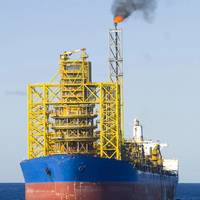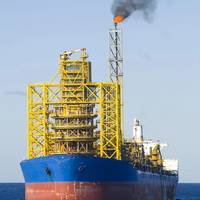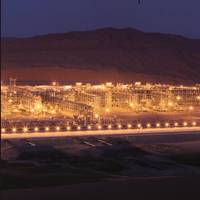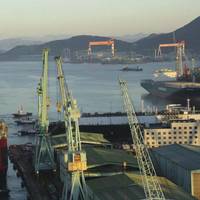Oil Hits Seven-year High

Oil prices surged to seven-year highs on Friday, extending their rally into a seventh week on ongoing worries about supply disruptions fueled by frigid U.S. weather and ongoing political turmoil among major world producers.Brent crude rose $2.16, or 2.4%, to settle at $93.27 a barrel having earlier touched its highest since October 2014 at $93.70.U.S. West Texas Intermediate crude ended $2.04, or 2.3%, higher at $92.31 a barrel after trading as high as $93.17, its highest since September 2014.Brent ended the week 3.6% higher…
Deepwater Investments to Grow +5% in 2020
Though overall global upstream investments in 2020 will decrease by around 4%, deepwater will be the only segment expected to grow above 5% next year, spelling a boom for the industry, said a report.Rystad Energy is forecasting that overall global upstream investments in 2020 will decrease by around 4%. Investments in shale/tight oil are expected to contract the most next year by almost 12%.Rystad Energy believes that the lower oil price and weaker cash flows will force shale companies to reduce activity. Deepwater is the only segment expected to grow above 5% next year, spelling a boom for the industry.On a regional level, only Africa…
Non-Opec Supply Set to Surge
Liquid production growth for non-OPEC countries reached the highest rate on record in 2018, with a growth of almost 2.9 million barrels per day (bbl/d).For this year, the trend suggests that non-OPEC countries’ liquid production will reach above 2 million bbl/d once again, led by tight oil.Rystad Energy expects liquid production growth of non-OPEC countries will continue reaching record highs in 2020. However, despite strong tight oil production, offshore will have a much greater role on the market next year.Growth in offshore production from Norway and Brazil will bring the total offshore supply close to 1 million bbl/d. This will therefore be the third consecutive year to deliver liquid a production growth of more than 2 million bbl/d.Meanwhile…
US Shale to Peak at 14.5Mbpd in 2030
US shale supply will peak at approximately 14.5 million barrels per day (bpd) around 2030, said the energy research and business intelligence company Rystad Energy.In the past decade, crude oil coming from shale patches such as the Permian in the US has grown from a negligible contributor to an upstream behemoth, reshaping the industry and the oil market.US Light Tight Oil (LTO) represented less than 1% of global oil supply just nine years ago. Today, US LTO represents close to 10% of total global oil supply, a percentage which is expected to continue its ascent going forward. But by how much? That is the million-dollar question.Different agencies and knowledge houses have responded to this with varying degrees of positivity and skepticism.
Rates Slowdown in Permian Basin
Though the Permian Basin still dominates US land drilling, the pace of growth in this region has slowed significantly.Older tight oil wells decline by 20% per year without material intervention, according to Rystad Energy.Contrary to common belief, the Permian Basin systematically offers the lowest oil decline rates, along with the Bakken Shale.In turn, the Eagle Ford and DJ basins exhibit steeper decline rates throughout the first eight years of production across most vintages.Rystad Energy has examined all horizontal oil-producing wells in the Bakken, Eagle Ford, Permian and DJ Basins, turned-in-line between 2011 and 2017 with at least 24 months of reported production.The resulting sample includes 146,158 annualized production data points from 46,188 wells.
Gazprom Lead Oil and Gas Growth Worldwide
Russian giant Gazprom saw the most production growth among world’s exploration and production (E&P) companies during the five-year span from 2014 through 2018.It’s followed by Chinese player PetroChina Company Limited and U.S. shale company EQT Corporation ranking second and third, respectively, said energy research firm Rystad Energy.Onshore resources – whether conventional or unconventional – are a major driver of growth, it said.“Gazprom, the clear leader in production growth, is the only company with a total growth of more than 1 million barrels of oil equivalent per day (boepd) over the last five years,” said Espen Erlingsen, Rystad’s head of upstream research.
US Leads World Oil Reserves
The United States has a world-leading 293 billion barrels of recoverable oil resources, which is 20Bbbl more than Saudi Arabia and 100Bbbl more than Russia, with the Permian Basin leading that charge.Rystad Energy’s estimate of US recoverable oil is also five times more than officially reported proven reserves as published in the BP Statistical Review of World Energy 2019.Tight oil plays in the Permian Basin in Texas and New Mexico now hold 100 billion barrels of recoverable oil resources, according to Rystad Energy’s analysis. Shale/tight resources in the Permian thus remain largely flat from the previous year, as production has been replaced through improvements in well configuration…
US Oil Output Heads for More Records in 2019
U.S. total oil production, which is already off to an amazing start in 2019, is on track to set another record for this year.New records are expected both when the final numbers for May emerge and at the end of the year, said Rystad Energy.The energy research and business intelligence company is raising its forecast for US crude output to 13.4 million barrels per day (bpd) by December 2019. For May 2019, our research and calculations point to crude oil production averaging 12.5 million bpd. Both are new all-time highs.“Our US supply projections have been revised up yet again. US oil production is already higher than many in the market believe…
U.S. Shale: World’s 2nd Cheapest Source of Supply in Oil
North American tight oil is emerging as the second cheapest source of new oil volumes globally, just shy of the Middle East onshore market, Rystad Energy said.The U.S. shale oil was the world’s second most expensive oil resource just four years ago, the energy research and business intelligence company pointed out.“As the majors are struggling to replace conventional liquids, a wealthy source of additional resources is tight oil,” says Espen Erlingsen, Head of Upstream Research at Rystad Energy.Tight oil – such as onshore shale oil in the US – has witnessed an impressive turnaround over the last few years. In 2015, North American shale ranked as the second most expensive resource according to Rystad Energy’s global liquids cost curve…
Oil and Gas Projects to Triple in 2019
A surge in final investment decisions (FIDs) this year on new petroleum projects worldwide could see sanctioned volumes of oil and gas – excluding shale and tight oil and gas prospects – nearly triple compared to last year’s tally.The collective volumes could swell past 46 billion barrels of oil equivalent (boe), according to research conducted by Rystad Energy.“We expect global FID volumes in 2019 to triple over last year, and 2019’s megaproject awards could lead to billions of subcontracting dollars in coming years,” said Rystad Energy upstream research analyst Readul Islam.He added: “The only supply segment likely to shrink this year is the oil sands, whereas deepwater, offshore shelf and other conventional onshore developments are all poised to show substantial growth.
Oil Trades Strengthen to Mid-2015 Levels on Iranian Unrest

Oil prices posted their strongest opening to a year since 2014 on Tuesday, with crude rising to mid-2015 highs amid large anti-government rallies in Iran and ongoing supply cuts led by OPEC and Russia. U.S. West Texas Intermediate (WTI) crude futures traded flat at around $60.40 by 1200 GMT after hitting $60.74 earlier in the day, their highest since June 2015. Brent crude futures, the international benchmark, were also flat at around $66.80 after hitting a May 2015 high of $67.29 a barrel earlier in the day.
Deepwater Downturn: Bump in the Road or Long-Term Slowing of Growth?

IMA/World Energy Reports has just completed a comprehensiveassessment of the five year outlook for the deepwater sector. The new report – the 19th annual floater market forecast prepared by IMA since 1996 -- provides our forecast of orders for floating production systems between 2016 and 2020. Here’s an overview of the findings and conclusions in the report. We see the downturn in market conditions and implosion of Petrobras as a bump in the road. While the outlook is clearly dimmer than last year…
Deepwater Downturn: Bump in the Road or Long-term Slowdown?

IMA/World Energy Reports has just completed a comprehensive assessment of the five year outlook for the deepwater sector. The new report – the 19th annual floater market forecast prepared by IMA since 1996 – provides our forecast of orders for floating production systems between 2016 and 2020. Here’s an overview of the findings and conclusions in the report. We see the downturn in market conditions and implosion of Petrobras as a bump in the road. While the outlook is clearly dimmer than last year…
Deepwater Downturn: Bump in the Road or Long-term Slowdown?

IMA/World Energy Reports has just completed a comprehensive assessment of the five year outlook for the deepwater sector. The new report – the 19th annual floater market forecast prepared by IMA since 1996 – provides our forecast of orders for floating production systems between 2016 and 2020. Here’s an overview of the findings and conclusions in the report. We see the downturn in market conditions and implosion of Petrobras as a bump in the road. While the outlook is clearly dimmer than last year…
OPEC: Crude Demand will Grow in 2016
OPEC on Monday predicted higher demand for its crude oil next year, sticking to its view that a strategy of letting prices fall will tame the U.S. shale boom and cut a global surplus. The monthly report from the Organization of the Petroleum Exporting Countries also said a weaker outlook for China would contribute to slower global oil demand growth next year. "U.S. oil production has shown signs of slowing," OPEC said in the report. OPEC said it expected demand for its crude next year to average 30.31 million barrels per day (bpd), up 190,000 bpd from last month, despite the slower demand growth overall due to a weaker outlook for Latin America and China. Oil is trading below $50 a barrel, less than half its level of June 2014.
Energy Outlook Lowers Crude Price Forecast
The Short-Term Energy Outlook (STEO) released on August 11 forecasts that North Sea Brent crude oil prices will average $54 per barrel (b) in 2015 and $59/b in 2016, which is $6/b and $8/b lower than projected in last month’s STEO, respectively (Figure 1). The price decline reflects concerns about lower economic growth in emerging markets, expectations of higher oil exports from Iran, and continuing growth in global inventories. WTI prices are expected to average $5/b below Brent in both 2015 and 2016. EIA’s updated projection remains subject to significant uncertainties as the oil market moves toward balance. During this period of price discovery, oil prices could experience periods of heightened volatility.
‘Business as Unusual’ for Oil in the Medium Term

The recent crash in oil prices will cause the oil market to rebalance in ways that challenge traditional thinking about the responsiveness of supply and demand, the International Energy Agency (IEA) said in its annual Medium-Term Oil Market Report (MTOMR). The U.S. light, tight oil (LTO) revolution has made non-OPEC production more responsive to price swings than during previous market selloffs, the report said, adding that this would likely set the stage for a relatively swift recovery.
Rebalancing Trade Flows
Many types of crude oil are produced around the world. Depending on the requirements of a particular refinery, a blend of heavy and light crudes is processed to manufacture a variety of petroleum products. After peaking at 9.6 million b/d in 1970, US crude oil production steadily declined until reaching a low of 4.94 million b/d in 2008. From 1970 to 2008, US crude oil imports increased sharply to bridge the gap of decreasing domestic supply and increasing demand. In response to declining North American production and anticipation of rising heavy grade imports from the Caribbean, Latin America and Saudi Arabia, many US refineries were reconfigured to process a heavy crude slate in the 1990’s.
Oil Continues Downward Spiral
The latest report from the U.S. • North Sea Brent crude oil spot prices fell by more than 15% in November, declining from $85/barrel (bbl) on November 3 to $72/bbl on November 28. Monthly average Brent crude oil prices have declined 29% from their 2014 high of $112/bbl in June to an average of $79/bbl in November, the lowest monthly average since September 2010. The November price decline reflects continued growth in U.S. tight oil production along with weakening outlooks for the global economy and oil demand growth. • The current values of futures and options contracts suggest high uncertainty in the price outlook (Market Prices and Uncertainty Report). WTI futures contracts for March 2015 delivery, traded during the five-day period ending December 4, averaged $67/bbl.
Lower Oil Prices Start to Pinch Oklahoma State Revenues
The plunge in oil prices is starting to hurt Oklahoma's energy-related revenues and if the price remains low, could hit income and sales tax revenues if energy workers have less money to spend, the state's treasurer said on Friday. The monthly numbers for November show the first year-on-year decline in energy tax revenues for the state in 19 months. Overall state revenues remained healthy, but the state treasurer expressed caution. "We are beginning to see the signs of softening prices, but we've not yet seen the impact of these extremely low prices of below $70. That will take a few months to get in," Ken Miller, Oklahoma State Treasurer, told Reuters on the sidelines of the National Association of State Treasurers' conference.
What’s New in Floating Production?

What’s New in October 2014? Today 324 oil/gas floating production units are now in service, on order or available for reuse on another field. FPSOs account for 65% of the existing systems, 78% of systems on order. Production semis, barges, spars and TLPs comprise the balance. The oil/gas production floater inventory is the same as last month. There were no orders for additional production systems in September. Another 30 floating LNG processing systems are in service or on order. Liquefaction floaters account for 17%, regasification floaters 83%.
Exxon CEO: Lifting Crude Export Ban Would Create US Jobs

Scrapping a decades-old ban on U.S. crude oil exports would spur job creation and boost energy security by encouraging new investment that lifts production, Exxon Mobil Corp's chief executive said on Thursday. Chief Executive Officer Rex Tillerson, speaking to a business group, said trade restrictions should also be lifted for exports of liquefied natural gas, or LNG, which are subject to lengthy regulatory reviews. Dozens of companies are lining up to export LNG and a superlight type of crude oil known as condensate as U.S.
Floating Production Roundup: August 2014

There are 320 oil/gas floating production units are now in service, on order or available for reuse on another field. FPSOs account for 64% of the existing systems, 79% of systems on order. Production semis, barges, spars and TLPs comprise the balance. Total oil/gas inventory is the same as last month – but two units on order last month (N’Goma FPSO and Delta House Semi) were completed and are now in the active inventory. Another 29 floating LNG processing systems are in service or on order. Liquefaction floaters account for 17%, regasification floaters 83%.







